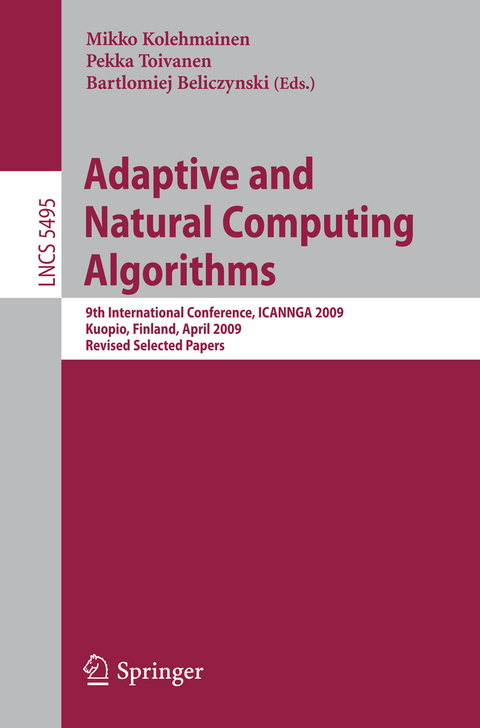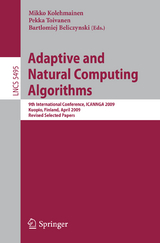Adaptive and Natural Computing Algorithms
Springer Berlin (Verlag)
978-3-642-04920-0 (ISBN)
Neural Networks.- Automatic Discriminative Lossy Binary Conversion of Redundant Real Training Data Inputs for Simplifying an Input Data Space and Data Representation.- On Tractability of Neural-Network Approximation.- Handling Incomplete Data Using Evolution of Imputation Methods.- Ideas about a Regularized MLP Classifier by Means of Weight Decay Stepping.- Connection Strategies in Associative Memory Models with Spiking and Non-spiking Neurons.- Some Enhancements to Orthonormal Approximation of 2D Functions.- Shortest Common Superstring Problem with Discrete Neural Networks.- A Methodology for Developing Nonlinear Models by Feedforward Neural Networks.- A Predictive Control Economic Optimiser and Constraint Governor Based on Neural Models.- Computationally Efficient Nonlinear Predictive Control Based on RBF Neural Multi-models.- Parallel Implementations of Recurrent Neural Network Learning.- Growing Competitive Network for Tracking Objects in Video Sequences.- Emission Analysis of a Fluidized Bed Boiler by Using Self-Organizing Maps.- Network Security Using Growing Hierarchical Self-Organizing Maps.- On Document Classification with Self-Organising Maps.- Evolutionary Computation.- A Heuristic Procedure with Guided Reproduction for Constructing Cocyclic Hadamard Matrices.- Tuning of Large-Scale Linguistic Equation (LE) Models with Genetic Algorithms.- Elitistic Evolution: An Efficient Heuristic for Global Optimization.- Solving the Multiple Sequence Alignment Problem Using Prototype Optimization with Evolved Improvement Steps.- Grid-Oriented Scatter Search Algorithm.- Agent-Based Gene Expression Programming for Solving the RCPSP/max Problem.- Feature Selection from Barkhausen Noise Data Using Genetic Algorithms with Cross-Validation.- Time-Dependent Performance Comparison of Evolutionary Algorithms.- Multiobjective Genetic Programming for Nonlinear System Identification.- NEAT in HyperNEAT Substituted with Genetic Programming.- Simulation Studies on a Genetic Algorithm Based Tomographic Reconstruction Using Time-of-Flight Data from Ultrasound Transmission Tomography.- Estimation of Sensor Network Topology Using Ant Colony Optimization.- Learning.- Scalability of Learning Impact on Complex Parameters in Recurrent Neural Networks.- A Hierarchical Classifier with Growing Neural Gas Clustering.- A Generative Model for Self/Non-self Discrimination in Strings.- On the Efficiency of Swap-Based Clustering.- Sum-of-Squares Based Cluster Validity Index and Significance Analysis.- Supporting Scalable Bayesian Networks Using Configurable Discretizer Actuators.- String Distances and Uniformities.- Emergent Future Situation Awareness: A Temporal Probabilistic Reasoning in the Absence of Domain Experts.- Efficient Hold-Out for Subset of Regressors.- Improving Optimistic Exploration in Model-Free Reinforcement Learning.- Improving Visualization, Scalability and Performance of Multiclass Problems with SVM Manifold Learning.- A Cat-Like Robot Real-Time Learning to Run.- Controlling the Experimental Three-Tank System via Support Vector Machines.- Feature-Based Clustering for Electricity Use Time Series Data.- The Effect of Different Forms of Synaptic Plasticity on Pattern Recognition in the Cerebellar Cortex.- Soft Computing.- Fuzzy Inference Systems for Efficient Non-invasive On-Line Two-Phase Flow Regime Identification.- Machine Tuning of Stable Analytical Fuzzy Predictive Controllers.- Crisp Classifiers vs. Fuzzy Classifiers: A Statistical Study.- Efficient Model Predictive Control Algorithm with Fuzzy Approximations of Nonlinear Models.- Dynamic Classifier Systems and Their Applications to Random Forest Ensembles.- A Fuzzy Shape Descriptor and Inference by Fuzzy Relaxation with Application to Description of Bones Contours at Hand Radiographs.- Hough and Fuzzy Hough Transform in Music Tunes Recognition Systems.- Bioinformatics.- Multiple Order Gradient Feature for Macro-Invertebrate Identification Using Support Vector Machines.- Bayesian Dimension Reduction Models for Microarray Data.- Gene Selection for Cancer Classification through Ensemble of Methods.- Applications.- Rules versus Hierarchy: An Application of Fuzzy Set Theory to the Assessment of Spatial Grouping Techniques.- A Novel Signal-Based Approach to Anomaly Detection in IDS Systems.- Extracting Discriminative Features Using Non-negative Matrix Factorization in Financial Distress Data.- Evolutionary Regression Modeling with Active Learning: An Application to Rainfall Runoff Modeling.- Gene Trajectory Clustering for Learning the Stock Market Sectors.- Accurate Prediction of Financial Distress of Companies with Machine Learning Algorithms.- Approximation Scheduling Algorithms for Solving Multi-objects Movement Synchronization Problem.- Automatic Segmentation of Bone Tissue in X-Ray Hand Images.- Automatic Morphing of Face Images.- A Comparison Study of Strategies for Combining Classifiers from Distributed Data Sources.- Visualizing Time Series State Changes with Prototype Based Clustering.
| Erscheint lt. Verlag | 15.10.2009 |
|---|---|
| Reihe/Serie | Lecture Notes in Computer Science | Theoretical Computer Science and General Issues |
| Zusatzinfo | XVI, 630 p. |
| Verlagsort | Berlin |
| Sprache | englisch |
| Maße | 155 x 235 mm |
| Gewicht | 979 g |
| Themenwelt | Mathematik / Informatik ► Informatik ► Betriebssysteme / Server |
| Informatik ► Software Entwicklung ► User Interfaces (HCI) | |
| Schlagworte | Algorithm analysis and problem complexity • algorithms • Biocomputing • Bioinformatics • classification • Clustering • Evolution • evolutionary algorithms • evolutionary computation • Evolutionary Computing • Fuzzy Sets • Genetic algorithms • Hardcover, Softcover / Informatik, EDV/Informatik • learning • Multi-agent Systems • Natural Computing • neural computing • Searching • security • self organization • self organizing maps • Visualization |
| ISBN-10 | 3-642-04920-6 / 3642049206 |
| ISBN-13 | 978-3-642-04920-0 / 9783642049200 |
| Zustand | Neuware |
| Haben Sie eine Frage zum Produkt? |
aus dem Bereich




